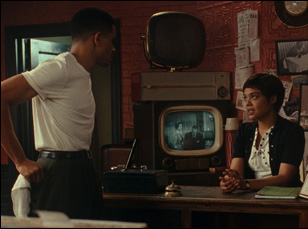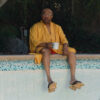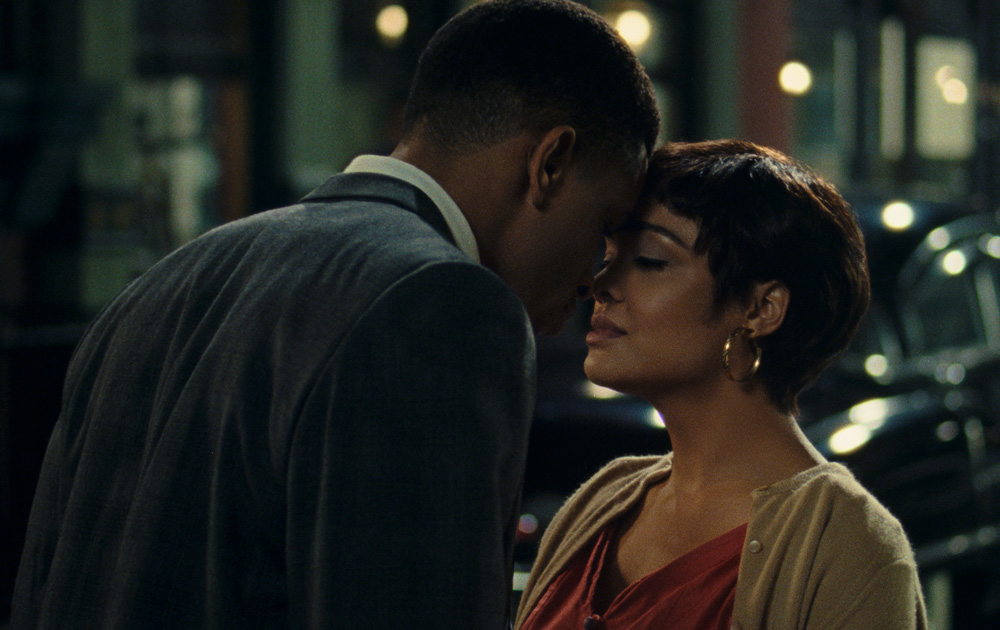When Eugene Ashe began thinking of pursuing his second feature, he started perusing old photo albums, looking back at his upbringing in an upper middle class neighborhood in Harlem, a place he had rarely seen on screen before.
“It just really came down to looking at pictures of my family from that time and feeling like those photographs of Black life really told a different story than I had seen depicted in other films,” said Ashe of the inspiration behind the swoony romance “Sylvie’s Love.” “Most of the time when we have films set in the ’60s, they usually focus on the civil rights movement or a traumatic event, so I just felt like I wanted to tell a story with these glamorous, elegant people I saw in my family photo albums.”
It would turn out to be the most radical thing Ashe could possibly do when “Sylvie’s Love” offers the deep satisfaction and comfort that any Rock Hudson-Doris Day romance could, yet the lingering sense of disappointment that audiences have long been denied seeing this part of the Black experience. As personal as “Sylvie’s Love” is, with Ashe taking inspiration from how his own parents created a life together during the 1950s and from his own career, which has taken some unexpected turns, the writer/director crafts the kind of frothy diversion that it’s easy to get lost in with two leads that are quite easy on the eyes in Tessa Thompson and Nnamdi Asoghmua, who star as Sylvie and Robert, a pair of lovers who find it hard for their professional ambitions and their personal lives to align.
While the two are so charming it may seem like it would take some suspension of disbelief to ever think they can’t work things out, in spite of the fiance Sylvie has when she and Robert first meet and Robert’s talent as a saxophonist leading him to consider a tour overseas, there’s a sophistication Ashe instills a sophistication in structuring the story that’s tantamount to the class his characters exude, bringing to light the real issues Sylvie and Robert face apart from those related to race as they struggle with ups and downs at work and finding time for one another when they can be in the same place. It’s an exquisite drama, and one that Ashe was well-prepared for beyond being familiar with the milieu, able to draw on banter from his days in the ‘90s R & B group The Funky Poets to make the scenes between Robert and his bandmates come alive and his interest in interior design, first as a student at Parsons and then in the research department at the History Channel, leading to extraordinary period detail.
When the name of Ashe’s production company Seven Letter Words was based on the Scrabble achievement of using all seven tiles in the rack on a single play, “Sylvie’s Love” packs the emotional wallop of seeing someone put everything together and following the film’s premiere at Sundance earlier this year, it is now truly one of the great gifts to be unwrapped this holiday season, making its debut on Amazon Prime. With the film now streaming, Ashe spoke about how he pulled off such a tender drama and gave it the grand production values of Old Hollywood on a contemporary indie film budget.

It talks about how when Sylvie and Robert first meet neither one have taken off in their careers, and really how, when you have unfinished business with the love of your life, it can set you on a path of arrested development in other areas of your life, like your career or your other relationships with people until you’ve resolved that relationship. It’s also about how outside forces can contribute to decisions you make and how other people can influence the decisions you make with your life. Dramatically, that’s what it centered in. And what Robert and Sylvie do is they are both willing to sacrifice the love itself because they recognize the passion in each other for what it is they’re trying to achieve, so they won’t hold the person back, which I thought was a really interesting thing to investigate.
When you’ve moved between careers as a musician and a filmmaker, did that contribute to not only to the authenticity of the music, but just having the perspective to see how careers play out?
Yeah. Without a doubt. In my own career, I had a record deal with Sony and I was doing a lot of R&B. It was what my band did. And I watched as that was falling out of fashion and vogue as hip hop was coming more into prominence and becoming more of culturally the music that everyone was listening to, so I was also interested in investigating that — what happens when one form of music goes out of fashion and another one comes in, which happens in Robert’s case with jazz and the birth of Motown.
I’ve heard that music just in general would inspire scenes for you. Did you really did embed songs into the script?
Often, I’d be listening to a certain song while I was writing a scene or it was evoking nostalgia or an emotion in me that I was trying to get that feeling across, so I would envision the scenes playing out to such songs, like the opening with this beautiful Nancy Wilson song, “The Nearness of You.” That happened a lot throughout, thinking about what song they were dancing to in the middle of the street. All of these things evoke a mood, and that’s really what it’s about. It’s pictures and sounds in a movie. Even silent movies had music, so it’s important.

It did, without a doubt. Originally, I thought of making a more intimate indie movie, more like “Carol” or “A Single Man.” And when I got on those backlots, the reason for it was simply the scheduling — Tessa basically had February [open] and we couldn’t shoot a movie set in the summertime in New York in February, but we could shoot it here [in Los Angeles], weather permitting. so we wound up on these backlots because I needed to recreate Harlem. That’s the only place you really find those brownstones like that. So once I got on [the lot], you could feel the weight and the ghosts of all of the big Hollywood movies that were shot there in the past. And it just makes you rise to the occasion and want to make that type of movie. It was set during that time and it was about love and glamour, so it just made perfect sense. I leaned into shooting there and making that type of movie, and I realized that I needed to make something bigger in scope, even though we didn’t have more money, so I had to find crafty and tricky ways to get that look without having more budget for it.
One of the shortcuts is how you’re able to reflect the power dynamics through the really smart blocking of the actors – what kinds of conversations were you having to get there?
That actually has to do with Tessa because I’ll be frank, Tessa is a genius at blocking. She knows where she needs to be and she’s just done everything from really small indies to big Marvel films, so she is really a master at blocking. I learned a lot from her on this movie and I knew what I was trying to achieve, but she knew really where her body needed to be, so I just referred to her a lot on that.
Is it true you’d occasionally break out the vocal chords on set to keep the crew focused?
[laughs] There were several times when I had to set Tessa and other members of the crew and cast straight — sometimes it’d be cold and Tessa would just have a gown on, so she would have a big coat on right up until when we shot and then she took the coat off and there wouldn’t be time really between the shots for her to put the coat back on, so I would go and entertain her. Let’s put it that way.“Sylvie’s Love” is now streaming on Amazon Prime.




